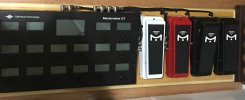Joel Walker
Member
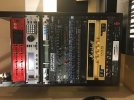
This is my guitar rack. It is a permanent installation, as live performance is not a goal. It does facilitate recording, and is part of a larger home studio. Please enjoy a quick tour & tell me what you think in the comments!
My guitar is a Gibson Les Paul Standard (black), which has been with me for almost three decades. The preamp and power amp are all-tube rack-mount units, respectively a Mesa/Boogie TriAxis (Recto+Phat) and a Marshall 9100 (50+50 watts stereo, 6L6GC @35mA).
I personally prefer studio-style equipment over pedals, and sought out modular racked components for applications which i) are employed persistently, ii) don’t require continuous control, iii) exist more authentically in the analog domain, and/or iv) favor forward placement in the signal chain. This includes traditional “channel strip” elements like gating (Decimator ProRack G), compression (dbx 160A), and equalization (Symetrix 551E five-band parametric + LP/HP), plus convenience features like an always-on, optionally silent tuner (Peterson StroboRack) as well as iconic single-taskers such as a CryBaby Wah (Dunlop DCR-2SR).
For effects that i) are employed situationally, ii) favor continuous modulation or programmability, iii) provide greater fidelity in the digital domain, and/or iv) prefer placement late in the signal chain, I wanted a single powerful, flexible, and pristine solution. I’ve coveted Eventide’s Ultra-Harmonizers since discovering Vai’s Passion and Warfare (on cassette, used, at age 15), so there was no other choice for me than the H7600.
My guitar is a Gibson Les Paul Standard (black), which has been with me for almost three decades. The preamp and power amp are all-tube rack-mount units, respectively a Mesa/Boogie TriAxis (Recto+Phat) and a Marshall 9100 (50+50 watts stereo, 6L6GC @35mA).
I personally prefer studio-style equipment over pedals, and sought out modular racked components for applications which i) are employed persistently, ii) don’t require continuous control, iii) exist more authentically in the analog domain, and/or iv) favor forward placement in the signal chain. This includes traditional “channel strip” elements like gating (Decimator ProRack G), compression (dbx 160A), and equalization (Symetrix 551E five-band parametric + LP/HP), plus convenience features like an always-on, optionally silent tuner (Peterson StroboRack) as well as iconic single-taskers such as a CryBaby Wah (Dunlop DCR-2SR).
For effects that i) are employed situationally, ii) favor continuous modulation or programmability, iii) provide greater fidelity in the digital domain, and/or iv) prefer placement late in the signal chain, I wanted a single powerful, flexible, and pristine solution. I’ve coveted Eventide’s Ultra-Harmonizers since discovering Vai’s Passion and Warfare (on cassette, used, at age 15), so there was no other choice for me than the H7600.
A MIDI foot controller (Mastermind GT16) and loop-switcher (Mini Effect Gizmo) from RJM Music Technology provide for complete flexibility and real-time continuous control. The GT16 connects to the rack via a single RJM 7-Pin MIDI cable with integrated power.
I designed and constructed a MIDI-to-analog interface, which is used to activate and modulate the filter sweep on the DCR-2SR, and likewise regulate its integrated passive volume loop. ( see build details on Instagram )
Four expression pedals (Mission EP-1 black X 2, SP-1 red, and SP-1 white) are board-mounted with the GT16. The outer pedal is strictly assigned to volume. The second pedal is spring loaded, and used strictly for wah; activation is triggered via positional detection on the GT16. The other two pedals are available for generic switching and parameter sweeps.
Programmable switches on the TriAxis control voicing on the Marshall.
I designed and constructed a MIDI-to-analog interface, which is used to activate and modulate the filter sweep on the DCR-2SR, and likewise regulate its integrated passive volume loop. ( see build details on Instagram )
Four expression pedals (Mission EP-1 black X 2, SP-1 red, and SP-1 white) are board-mounted with the GT16. The outer pedal is strictly assigned to volume. The second pedal is spring loaded, and used strictly for wah; activation is triggered via positional detection on the GT16. The other two pedals are available for generic switching and parameter sweeps.
Programmable switches on the TriAxis control voicing on the Marshall.
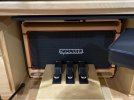
Stereo cabinets are an 8 Ohm, 120 Watt pair; these are a custom build, each with dual ports, dual 12 inch speakers (Celestion Vintage 30 + Classic Lead 80), and a switchable high-pass filter. Thanks to Tim Metzger at TRM GuitarCabs for inspiration and tips. ( see build details on Instagram )
Additional equipment (much of which is in the back of the rack) includes a linear AC power conditioner (Furman PF-Pro R), a transformer-isolated low-voltage power supply (MXR/CAE MC403, modified to provide 24V AC for the wah), passive transformer-based DI and ReAmp boxes (Radial JDI Stereo and JCR), a stereo line-isolator (Radial SB-6), a pair of midi interfaces (Kenton Merge-4 and Thru-5, with custom riser), a custom input bay, custom switches for signal redirection, and a multi-channel mic preamp and thunderbolt 2 interface (Focusrite 8PreX). Guitar and patch cables are DiMarzio. All of this is strapped together with excessive quantities of Harbor Freight zip ties. I personally fabricated the rack frames (plus some support rails) and then had them professionally powder coated.
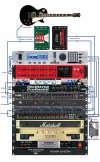
Signal goes first from the guitar into the DI, with the isolating transformer (with a turns ratio of 12:1) feeding a mic-input of the preamp/interface, providing a 144-fold increase in the input impedance (from 6.2 kOhms to just less than 1 MOhm). This comes at a cost of about 22dB in signal level and substantial gain is applied in the preamp to get up to line. An ultra-clean signal can be digitally recorded at this point. The interface can pass this signal through directly, or instead return a previously recorded signal from the DAW. Next comes the first stage of the noise gate (which includes tracking), then the wah (which feeds the tuner via an unaffected “thru”), and after that the MEG (unbuffered input). Loops provide switchable access to the compressor, the main stage of the Triaxis (into the instrument input via the reamp box and out of the FX send), and the equalizer, each roughly at unity gain. Signal exits the MEG (click stopper output), passes through the DCR-2SR volume loop, and then the second stage of the noise gate (last two stages reversed in diagram). After this, it splits into dual mono and passes through a pair of XLR adapters into the Eventide (this enables hardware bypass). Recordings from the interface can also be injected directly into the Eventide at this juncture via the SPDIF inputs. Stereo analog outputs feed the final gain stage (tube 5) of the TriAxis (via FX returns), which sends signal through the stereo line isolator to the Marshall, which sends power to the cabinets.
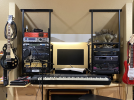
The studio side has two more basic power conditioners (Furman M-8X and M-8X2), a full-scale weighted keyboard MIDI controller (M-Audio ProKeys 88), three momentary foot pedals (M-Audio SP 2), a hardware sound module (Roland Integra-7), an integrated amplifer (Emotiva BasX TA-100), stereo 3-way bookshelf speakers (ELAC Uni-Fi UB5), a pair of sealed-back headphones (Sennheiser HD 569), various microphones (Sennheiser MK4 with suspension, e935, and e906), a computer-based DAW (Mac Mini with Logic Pro X), a 23 inch screen with adjustable mounting arm, a slide-out keyboard and trackpad rest, various electronic doodads (HDMI splitter, network switch, Apple TV), attached network storage (Netgear ReadyNAS 2304, 4x3TB Western Digital Red), and miscellaneous cables and fixtures (especially by Konig & Meyer). And a Stegosaurus. Connection to the interface on the guitar side is via an optical Thunderbolt cable (Corning, 5.5m) to deal with a nasty ground loop. The “kid's rack” consists of a short-scale guitar (Fender Squier Mini Statocaster, red), my ART SGX-2000 Express from college, and my 20 watt, 2x6 Crate practice amp from high school.
Thanks for reading!
-- Joel
( Posting mirrored compactly on Instagram )


